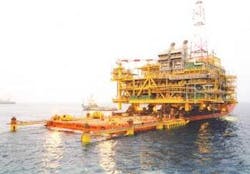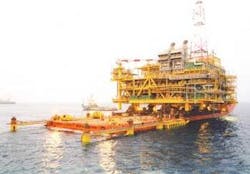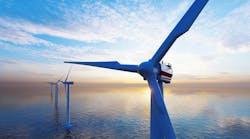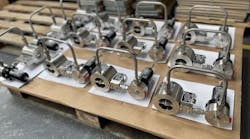Nick Terdre
Contributing Editor
TotalFinaElf is close to bringing the Am-enam/Kpono field off Nigeria onstream, an event that will move the company's operations in this country up a gear.
Production from the Amenam/Kpono Oil and Gas Export Project (Akogep) will make Total the fourth largest oil and gas producer in Nigeria. The new field facilities, which are integrated with the operations from the company's other producing fields off Nigeria, will serve as a hub for other developments.
The project has many impressive features, though Project Director Pierre Nerguararian is quick to point out that the water depth – 40 m – is not one of them. It calls for $2 billion to recover just under 1 Bboe, of which 580 MMbbl is oil and 56 bcm is gas.
Another $200 million has been spent on building the world's largest floating, storage, and offloading (FSO) barge, FSO Unity, which has 2.4 MMbbl storage capacity.
The project is on schedule for start-up in August. Plateau production of 125,000 b/d of oil and 15 MMcm/d of gas is expected for seven to eight years, while the total production life is put at 25 years. For the first two years, all produced gas will be reinjected; thereafter 8.8 MMcm/d will be exported to be used as feedstock at the Bonny LNG plant.
The project's very competitive development cost has earned Nerguararian the nickname "Mr. Two Dollars a Barrel," one that he accepts quite happily. But he also draws attention to other features of the project, such as high local content, commitment to sustainable development, and licens-ees' efforts to secure benefits for local communities.
Road to discovery
Although there is much to look forward to as Akogep unfolds, Total is keen not to forget the intriguing history of the Amenam discovery.
The company's activities in Nigeria date back to the 1970s, when the first licenses were awarded to Elf Production Nigeria Ltd., still the name of the Nigeria subsidiary following the merger of TotalFina and Elf in the late 1990s. In the mid 1980s, as production from the company's onshore Obagi field was declining, EPNL turned its attention to relinquished offshore acreage that was becoming available.
Interest in offshore exploration had been prompted by the realization that the prolific Delta sands onshore could extend offshore. A key breakthrough was made with the discovery of the Biafra sands play.
In partnership with the Nigerian National Petroleum Corp., EPNL was awarded four licenses in the eastern offshore sector. In 1986-87, it ran an extensive program of 3D seismic acquisition – probably the biggest in the world at that time, according to Jean Bié, who took over as exploration manager in 1988. Its priority was the two licenses containing acreage close to the Edop field discovered by Mobil. These have now been converted to production licenses OML 100 and OML 102. No extension of Edop was initially found, but two smaller fields were discovered – Odudu and Afia – and brought into production in 1992.
The partners then turned their attention to areas with higher risk and reward prospects, including what is now OML 99, which includes acreage from two previously relinquished licenses. Here, the seismic showed an interesting structure that coincided with the boundary between the two former licenses. EPNL could see the whole picture in a way that the two former licensees could not, Bié says.
Potentially, the structure represented a classic structural trap, but it lay very deep, around 4,000 m, beneath a high-pressure zone that would be difficult to drill and where potential reservoirs were not recognized at that stage of exploration. The presence of a strong seismic marker with strange features underlying the potentially hydrocarbon-bearing zone complicated interpretation. This seemed to mark the top of a very high-pressure zone, so it was decided not to drill beyond this point.
The well, Amenam-1, was drilled in 1990. As expected, drilling proved difficult, not least the passage through some 1,500 m of highly pressured shale. But beneath the shale the well found a quite normally pressured reservoir consisting of a huge column of hydrocarbons. Determining the nature of the hydrocarbons was not easy, Bié says. The first shows indicated oil, but subsequent logging suggested gas. The well was drilled further, logged again, and tested. Only then did it become apparent that the hydrocarbons were in a critical phase between liquid and gas, with continuous evolution from top to bottom of the column.
The final surprise emerged when the seismic velocity was tested, and it became apparent that the reservoir lay beneath the strong seismic marker at which drilling had been meant to stop. The fault was at 3,700 m depth, and not 4,000 m as had originally been calculated, Bié says.
Appraising the field proved another arduous task. In fact, it took six appraisal wells and another seven years before reservoir understanding was sufficient to allow formulation of a development plan. The field was also found to extend into the neighboring OML 70 license operated by ExxonMobil, which named its part of the field Kpono. To achieve the most cost-effective form of development, it was necessary to unitize the interests in two licenses – the first time this had happened in Nigeria. Under the agreed unitization, EPNL has 30.4%, NNPC 60%, and ExxonMobil 9.6% in Amenam/ Kpono.
Development challenges
One of the key development challenges is maintaining the original reservoir pressure of 400 bar to prevent oil from converting to gas, hence the decision to reinject all gas during the first two years. When gas export begins in 2005, water injection will replace the exported gas.
The first phase involves four platforms – two wellhead platforms, a process platform, and a quarters platforms – together with a flare tower. The process platform, AMP1, has an 11,500-metric-ton topsides with three main decks each the size of a soccer field. Gas separation will take place at atmospheric pressure, after which the gas will be compressed to 400 bar for injection. This requires four stages of gas compression involving seven compressors.
Float-over installation
EPNL decided that the most cost-effective means of building and installing AMP1 would be as an integrated deck with a maximum of onshore commissioning, and that this could best be achieved by holding a design competition for an engineering, procurement, construction, and installation contract. Such a design competition had not been held before in the Nigerian sector, but NNPC accepted the company's argument. Four contractor groups participating, Nerguararian says. In October 2000, the contract was awarded to a Saibos-led group offering Technip's Unideck float-over method of mating the deck with the jacket.
McDermott's Jebel Ali yard in Dubai built the topsides, and the Mighty Servant 3 heavy-lift barge, supported by eight jacks, towed it to the field earlier this year. The installation took place on March 13. Starting at noon, the topsides was floated between the sides of the eight-leg jacket and raised on the jacks while the barge was ballasted down. The jacking-down operation to transfer the load to the jacket was accomplished in just a minute and a half, and the installation of the topsides was completed 11 hours and 30 minutes later. It was then necessary to wait for the tide before the barge could be towed out from beneath the deck.
The second main contract, involving fabrication of the two drilling platforms, installation of the AMQ platform, and installation of pipelines, was awarded to Stolt Offshore. Layship Seaway Polaris carried out pipelay.
Maximizing local content
It was EPLN's policy to maximize local content, and the achievement of 28% in this respect, representing 1 million work-hours in Nigeria, was a satisfactory outcome, Nerguararian says. A significant part of the fabrication was carried out in Nigeria. AMD1 and AMD2 were built at Stolt's Globestar yard in Warri, and the AMT1 tripod, which supports the gas pipeline running from AMP1 to the flare tower, at Saibos' Nissco yard, also in Warri.
Other parts of the fabrication work were undertaken at the Lamprell yard at Jebel Ali, Eiffel's yard at Fos-sur-Mer in France, and Hyundai Heavy Industries' Ulsan yard in South Korea, where the FSO was built.
The FSO was expected to arrive at its installation site in mid April. In addition to Amenam, it will also serve the Odudu and Ofon fields, replacing the current FSO. It will receive a total of some 230,000 b/d from the three fields. It will be located between the Odudu and Ofon fields, which means that oil from Amenam will be transported to it via a 30-km, 16-in. pipeline to Odudu, and from there via an existing 24-in. line.
Drilling program
The two drilling platforms, AMD1 and AMD2, each of which has 18 well slots, were installed in spring 2002, and GlobalSantaFe jackups Baltic I and Adriatic I are now carrying out drilling. At start-up, there are expected to be eight production wells and two or three gas injectors. The drilling program calls for 34 wells in the two phases, consisting of 18 producers, five gas injectors, and 11 water injectors.
In phase two, a second process platform, AMP2, and a third wellhead platform, AMD3, will be installed. AMP2, which will be bridge-linked to AMP1, will also be large, with topsides of 9,000 tons, according to Nerguararian. It will process gas for export to Bonny and treat seawater for injection. Injection will take place at the nine-slot AMD3 platform, which will be located 2 km north of the field center. An 18-in. water pipeline will be laid from AMP2 to AMD3 and a 24-in. gas pipeline to Bonny. Saibos' and Stolt's contracts include options for the provision of the second phase facilities, though it has not yet been decided whether to exercise them, Nerguararian says.
Smooth transition
EPNL has worked to ensure a smooth transition from development to production. Forty Nigerian operating staff underwent extensive training in France and participated in the deck commissioning. They are now familiarized with how the platform works. The company has an active policy of technology transfer to Nigeria, and has also had NNPC personnel integrated in the project team.
The project has also been planned in accordance with the principles of sustainable development, Nerguararian says. Under normal conditions, there will be no flaring. Among other measures, all solid waste from the quarters platform will be compacted and taken ashore, while the oil content in produced water discharged to the sea will be well below the 40 ppm required by the authorities. Nigeria's environmental requirements are already strict, but with a 25-year production life, EPNL has tried to anticipate possible future measures.
Even when Amenam/Kpono comes onstream, the story will only have been partly written. The plan involves developing reserves in the field's western and central parts. Reserves in the eastern part, which is separated by a major fault, have yet to be fully appraised. But there is every sign that they are commercial and will eventually add another interesting chapter to this story.






